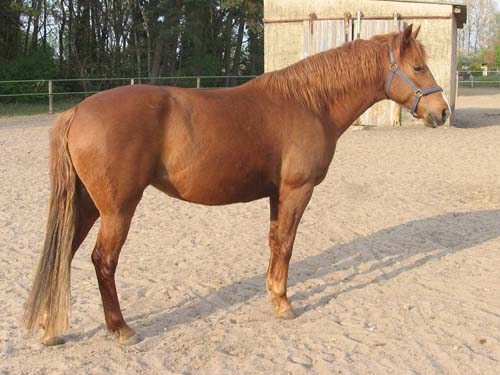
The Barb Horse is the only other breed of horse that can boast of a long history after the Arabian Horses. There are assumption that this horse breed may be even more ancient compared to the Arabian horses, but there is no evidence to prove the same. Like the Arabian Horses, the Barb Horses too have played a significant role in the development of most other horse breeds in the world.
Just like the Arabian horses, the Barbs too are desert horses. But that is the end to the similarity between the two breeds. The height of the Barb horses varies between 13.3 -15.2 hands. This horse has a straight profile. The neck of the horses in the breed is slightly arched and they have upright shoulders that are flat. The front end of this horse is powerful and the withers are high. The hindquarters of this horse are rounded, but sloping and narrow. The tail is set low on the short back. Its slender legs are hardy and clean. The feet are narrow and durable and the sound hooves of this horse are small and round. The varieties of Barbs in existence today are the Algerian, Tunisian and Moroccan Barbs.
Though the gait of this horse is not perfect, it has the potential to gallop like a sprinter. The trait of this horse has influenced other breeds like Thoroughbred, Standarbred and American Quarter Horse which are the breeds that carry the Barb strain. These horses have great stamina and can travel long distances on limited food supplies. This horse is resistant to droughts and the movement is agile.
Size
13.3 -15.2 hands
Colours
Though the most common coat color of this breed is grey, horses with other colors like chestnut, black, bay and brown that can be found.
Suitable for
The Barb horses are used as military horses and for agricultural purposes. These horses are also used for general riding purposes. They also find their use in many competitions.
History
Though the exact place of origination of this breed is still under dispute, people consider that these horses originated in northern part of Africa around the 8th century. It is unsure whether this breed was the predecessor of the Arabian horses or is both these ancient breeds shared a common ancestor.
The spread of Islam to various countries in the Europe led to the introduction of this breed to the European soil. In Europe, this horse played a very significant role in the development of many European breeds. Spain, southern France, Algeria and Morocco are the primary breeding grounds for this breed. In 1987, The World Organization for Barb Horse was established in Algeria with the objective of promoting and preserving this breed.
:max_bytes(150000):strip_icc():format(webp)/what-horses-eat-that-keep-them-healthy-1886504-FINAL-5ba8dd3746e0fb0025eb2cb4.png)
:max_bytes(150000):strip_icc():format(webp)/horse-eye-resized-56a4dbf03df78cf77284fe95.jpg)
:max_bytes(150000):strip_icc():format(webp)/Horse-grooming-GettyImages-495726400-5876f27d5f9b584db351222e.jpg)
:max_bytes(150000):strip_icc():format(webp)/close-up-of-hand-holding-parrot-705172843-5b52bc4ec9e77c0037b6e5a4.jpg)
:max_bytes(150000):strip_icc():format(webp)/GettyImages-579524112-5c77331146e0fb000140a3a6.jpg)
:max_bytes(150000):strip_icc():format(webp)/budgerigarsonrope-331834_1920-5b628213c9e77c00255b32bc.jpg)
:max_bytes(150000):strip_icc():format(webp)/GettyImages-106887241-58325bc03df78c6f6a9a2ed2.jpg)
:max_bytes(150000):strip_icc():format(webp)/GettyImages-878015800-06106157c9d34a2081db4abcae8699b1.jpg)
:max_bytes(150000):strip_icc():format(webp)/hungry-cat-57b72fac5f9b58cdfda11a62.jpg)


:max_bytes(150000):strip_icc():format(webp)/4374985466_59c7f6545b_o-8b4f24f2f3e544349fe537fde58cfad0.jpg)
:max_bytes(150000):strip_icc():format(webp)/GettyImages-9298737261-500c5a2fba4248f89d1c17a33bf438f7.jpg)
:max_bytes(150000):strip_icc():format(webp)/veterinarian-and-owners-examining-dog-in-vet-s-surgery-164853745-dbecbdb691d549d79487d84356920cf4.jpg)